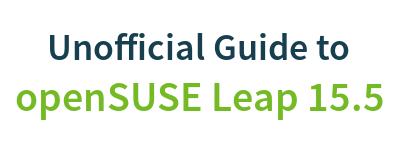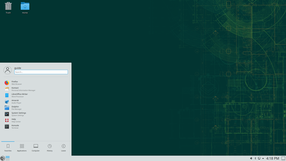| Updated: 8 June, 2023 |
|

|
 |
Getting Started
1. Introduction2. Switching to GNU/Linux
3. Getting openSUSE
4. Installation
The Fundamentals
5. KDE Plasma Workspace6. Apps for Common Tasks
7. Security and Root
8. Terminal
9. Admin. Settings (YaST)
10. Installing Software
11. Software Repositories
Setup
12. MS Windows Interop13. Multimedia Codecs
14. Graphics Drivers
15. Wifi
Appendix
A: Help and DocsB: Games
C. Under the Hood
D. History and Background
E: Getting Involved
GNU Free Documentation License
1. Introduction
The purpose of this guide is to provide new users with everything they need to know to get started using openSUSE Leap as a home user/small office desktop operating system - quickly and easily. Reading this guide should save you a lot of time in the long run. The appendix at the end is targetted at particularly enthusiastic readers.
Note that this guide is not officially related to the openSUSE project nor SUSE Software Solutions Germany GmbH.
Have a lot of fun!
1.1 About openSUSE Leap
openSUSE Leap is a PC operating system based on GNU and Linux. It's a free/open source and gratis alternative to e.g. Microsoft Windows with many advantages. openSUSE Leap is suitable for laptops, desktops, netbooks, servers and multimedia center PCs at home or in small offices. You can also run openSUSE on your ARM or PPC computer, but that is not covered by this guide.openSUSE Leap is among the leading GNU/Linux distributions and is also one of the oldest existing ones. openSUSE Leap uses a core system from SUSE Linux Enterprise but with up-to-date hardware support, desktop environments and graphical applications. Every year a major service pack is released and every 3-4 years there is a major new release where also the core system will be upgraded.
For experienced and adventurous GNU/Linux users who want to take risks with their operating system and live on the bleeding edge, there is also a rolling release version of openSUSE available called openSUSE Tumbleweed
openSUSE Leap is developed openly and transparently by community volunteers working together with SUSE employees.
1.2 Translations or Modified Versions
The sources of this guide are available for everyone on GitHub under the GNU Free Documentation License. This makes it easy to create your own modified or translated version. Current known active derivative versions are:
Send your comments via e-mail to admin [at] opensuse-guide.org
